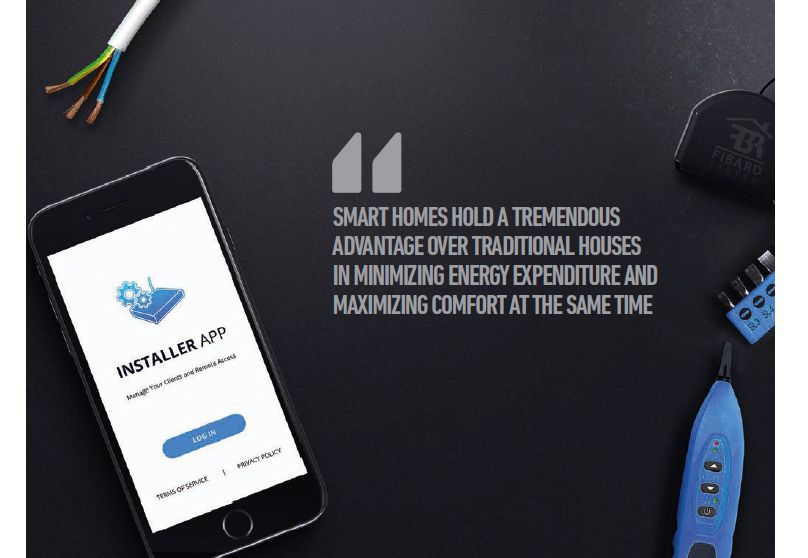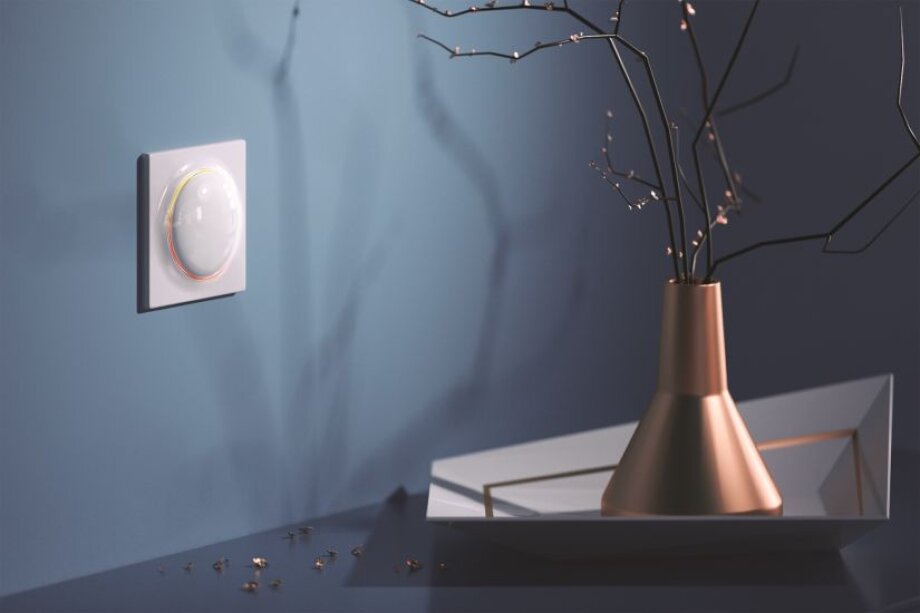The times when the internet used to be associated just with computers and mobile phones are in the past, and, thanks to the Internet of Things, we can now use our smartphones and tablets to remotely control other elements of our house, such as home appliances or lighting and heating systems. It may all seem a bit unreal, and some would say that home automation is a luxury few can afford. Meanwhile, it is becoming a standard in new homes, and the popularity of this trend is skyrocketing.
The numbers say it all. FIBARO, the Polish leader of the world’s smart technology market, observed a 47 percent growth in sales in 2018. The IDC report, in turn, states that by the end of 2019, some 832 million smart home devices will have been purchased globally. By 2022, the number is expected to rise to 939.7 million.
A big driver of that growth is the global trend towards minimizing our carbon footprint. It goes without saying that the new technology introduced to buildings holds great potential to limit the impact of human activities on the environment through a significant reduction of energy expenditure, leading to a decrease in the emission of harmful gases. According to the EU directive 2010/31/UE on the energy performance of buildings, each EU member state is obliged to obey the requirements concerning the effective use of energy in both new and old buildings.
HOW DOES IT WORK?
The elements that make homes smart can be divided into two groups: sensors and actuators. The former read and collect data on the building’s conditions, such us temperature, and transmit it to the central hub. The Building Management System, in turn, gathers the information delivered by sensors and connects with home appliances called actuators. This way, if the temperature is too high compared with the one we have set as optimal, the windows will close automatically and the air conditioning will be switched on.
Those who are fond of minimalistic interiors will be happy to find out that a great majority of smart components, such as cameras and sensors, go completely unnoticed. This means that it’s possible to upgrade our house without interfering with its design.
What’s important is that the idea of making homes smart is not based on developing separate systems. Instead, it focuses on integration. It is the “dialog” between particular devices that makes buildings a holistic ecosystem. The KNX standard for home applications, supported by over 300 producers, connects each and every device, equipped with dedicated software, into a coherent network transmitting data between all elements.
SAFE AND SOUND
One of the main benefits of smart home technology is the possibility to increase the safety of both houses and their inhabitants. According to a 2018 Smart Living report, Poles most often opt for motion and smoke sensors, as well as security cameras that send out a mobile alert every time an intruder enters their property.
Advanced security systems are in fact the most commonly used type of home automation systems. Around 41 percent of Polish homeowners and 26 percent of those residing in apartment buildings claim to be using or considering installing these smart home components.
One of the most useful features that takes houses’ safety to the next level is the intrusion detection systems. Combined with a smart lighting system, the technology allows presence simulation when the residents are away. It can be achieved thanks to motion sensors that recreate your typical day’s scenario and switch the lights on and off accordingly. And while you’re basking in the sun on a tropical island, security cameras footage can be accessed in HD on your smartphone any time.
Alternative gate codes that send out a silent SOS message add another security layer to your home. As soon as you type in the SOS code, the gate will open as usual, but the security firm will receive an urgent alert. It’s can be a life-saving feature when you enter your property with an unwelcome stranger, as your security system will send help in no time.
If you’ve ever forgotten to unplug the iron or left the oven on rushing to an important meeting, Smart Plugs are a real game-changer. They have a significant impact on energy costs, but what’s even more important, they also help to prevent serious accidents. When installed in our house, any electrical device can be turned off remotely using a smartphone. Smart Plugs also offer a feature called scheduling. After they have been set up, devices will turn on and off according to the time that has been set.

BUDGET-FRIENDLY
Whereas smart home devices tend to be pricy, they play a crucial role in preventing malfunctions that put our savings at risk. After all, a water leakage or a fire outbreak can cause enormous damage. Szymon Ochociński, Strategic Clients Manager at FIBARO, points out that smart home technology not only protects us from spending great sums on fixing our equipment, but it can also help us save on our bills. Thermostat controls and a mobile app are an easy combination that lets you set the right temperature according to your individual preferences. This feature is immensely useful given that over 30 percent of total energy consumption in both housing and commercial buildings comes from heating systems. The temperature can be set via a smartphone, meaning you can turn off the heating when no one is around and switch it back on when you’re on your way home to avoid entering a cold house.
Air conditioning and blinds system are controlled in the exact same way. Smart blinds, by limiting the amount of sunlight coming into the house, contribute to maintaining optimal temperature. This, in turn, minimizes the necessity to activate air conditioning, and therefore diminishes energy costs. A weather station is another component worth purchasing. By adjusting the amount of water used to water plants depending on the amount of rainfall, you avoid water waste and provide optimal conditions for your garden.
Producers of KNX devices claim that smart homes hold a tremendous advantage over traditional houses in minimizing energy expenditure and maximizing comfort at the same time. The authors of the Energy Efficiency with KNX report state that smart technology is vital for reducing energy use by up to 40 percent through the automatization of blinds and shutters systems and by 60 percent by equipping our house with smart lighting and ventilation systems.
LUXURY OR STANDARD?
When you put all these elements together, outfitting your home with smart devices can be quite expensive, but it doesn’t have to be. The world’s best smart devices producers offer modules for separate rooms, which lets us upgrade our house gradually. There are multiple options that make it easy to choose the sensors that suit our preferences and, most importantly, our budget. A basic set by FIBARO costs around PLN 2,000 and if you top it up with an additional PLN 500, you will get a central hub, a set of sensors and a Smart Plug.
But if you want to invest more, the sky is the limit. Smart fridges, for example, are equipped with the View Inside feature. Footage from cameras installed inside the appliance are transmitted directly into the smartphone so we know what we need while shopping in the supermarket; grocery lists become completely obsolete.
Another innovative option on the market are light strips equipped with Zigbee technology. These adjust the light temperature in our interiors to the time of day. After a quick and easy setup, cool lights give way to the warmer ones in the afternoon, making our quiet time more pleasant.
The brightness and color of light can be configured with the help of Alexa – Amazon’s virtual assistant. Other market giants’ brainchildren can react to voice commands too. The technology is not infallible, though, so one needs to be extra careful. Siri by iOS, Cortana by Windows or Google’s Assistant may react to your words or TV sounds, even when you least expect it.
HIGHER EXPECTATIONS
The prevalence of smart home technologies has raised the bar for developers, too. Home automation systems are quickly becoming standard in newly developed apartment buildings. According to Waldemar Olbryk, member of the Echo Investments’ Management Board, the safety and comfort of potential residents have become top priorities for new projects. Today’s housing estates commonly feature electric vehicle charging stations, car-sharing systems and parcel lockers. The first smart housing estate built by Echo Investments are Warsaw’s Widoki Mokotów and Moje Miejsce, as well as Wrocław’s Ogrody Graua. In the coming years, the developer plans to deliver around 4,500 apartments featuring the Echo Smart technology.
It seems the market for smart devices has nowhere to go but up. As demand grows, producers’ approaches are changing at a surprisingly rapid pace. While 2018 was all about selling as many smart accessories as possible, this year Amazon and Google are instructing consumers how to create advanced networks of smart devices. When it comes to the remote control of those systems, smartphones are predicted to be substituted to a great degree by smart watches. They are expected to play the main role in controlling almost 20 percent of all smart buildings in the coming years.


















